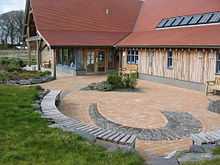George Waterston
George Waterston OBE FRSE (1911–1980) was a Scottish ornithologist and conservationist. He was born in Edinburgh, a son of the long-established family firm of printers and stationers.
He founded the Inverleith Field Club in 1929 [1] and co-founded what was the Midlothian Ornithologists' Club and is now the Scottish Ornithologists' Club.[2] He was their President, Secretary, Treasurer and Hon. President at various times.
He was also one of the founders of the Scottish Arctic Club with its Waterston Arctic Library, now held by the Royal Scottish Geographical Society.
He was Director of the Royal Society for the Protection of Birds in Scotland.
Pre-war
The Midlothian Ornithologists' Club were keen to maintain ornithological work on the Isle of May in the Firth of Forth and a migratory study centre was established. Waterston was influenced by Ronald Lockley's work on Skokholm specifically the use of Heligoland trap which Waterston and others erected in 1934 assisted by Lockley and others.[3]
George Waterston is probably best known for his interest in Fair Isle which he first visited in 1935 as a young man. He had great plans for the island, but these were interrupted by World War II. The Fair Isle Bird Observatory Trust was set up and founded in POW camp. George was appointed secretary and remained so until his death. He bought the island in 1947 and sold it for the same sum of money to the National Trust for Scotland in 1954.
Second World War
As a lieutenant in the Royal Artillery, he was involved with the Battle of Crete and he was captured in 1941. Whilst a prisoner of war, he laid plans for a bird observatory and birdwatchers' hostel, but also for other aspects of island life, e.g. a marketing scheme for the island's products, including Fair Isle knitwear.
In addition, he, along with John Buxton, Peter Conder and others, conducted ornithological work in Oflag VIB in Dossel (now part of Warburg) and Oflag VIIB prisoner-of-war camps.,[4][5][6] Waterston was the only serving British officer to contribute to a German scientific paper in wartime. Erwin Stresemann published his paper A survey of the birds of Crete and bird migratioin in the Aegean in the Journal fur Ornithologie and included Waterston's ornithological observations he made on Credte during the spring of 1941. He was repatriated in October 1943.
Post War
Waterston joined James Fisher on the Agricultural Research Council's Rook Survey before rejoining the family business. In 1955, Waterston was appointed half-time salaried secretary to the Scottish Ornithologists' Club but he had a vision for an ornithological centre. This became reality in 1959 with the purchase of 21 Regents Terrace, Edinburgh. His energies had so broadened the field of bird protection in Scotland that a full-time RSPB Director was required - a post he held for 13 years.
Waterston was largely responsible for the protection of newly returned ospreys in the 1950s. He organised a large team of observers who mounted a round-the-clock guard and placed barbed wire around the base of the nesting site.[7]
In the mid-sixties, his attention turned to Greenland and the Canadian Arctic where he joined several scientific expeditions.
Tributes
1949 - elected a Fellow of the Royal Society of Edinburgh.
1964 - awarded an OBE for services to ornithology and conservation.
1972 - awarded the RSPB Gold Medal.
1974 - Dundee University conferred a degree of LLD for his outstanding contribution.[8]
George Waterston tried to encourage other conservationists, among them Donald Watson, the wildlife artist; the Art Gallery at Waterston House is named after him.
Two bird-related centres bear George Waterston's name:
- Waterston House, the headquarters of the Scottish Ornithologists' Club at Aberlady, East Lothian and its Local Nature Reserve
- George Waterston Memorial Centre and Museum on Fair Isle
Books
Brown, P and Waterston, G. (1962). The Return of the Osprey. Collins.
References
- ↑ Obituary. Pennie, Ian D
- ↑ Mitchell , Anne (1993), “The People of Calton Hill”, Mercat Press, James Thin, Edinburgh, ISBN 1-873644-18-3.
- ↑ Country Life. Buxton, J and Waterston, G. 11.2.44 p239
- ↑ Mark Cocker Crow Country Vintage. p178-181, 203-4
- ↑ Stephen Moss. A bird in the Bush. Aurum. p157-8, 185
- ↑ Niemann, Derek. Birds in a Cage Short Books. p 115
- ↑ The Return of the Osprey. Brown, P and Waterston, G. RSPB/Collins. 1962
- ↑ Birds of Scotland p 102
See also
- Category:ornithologists
|